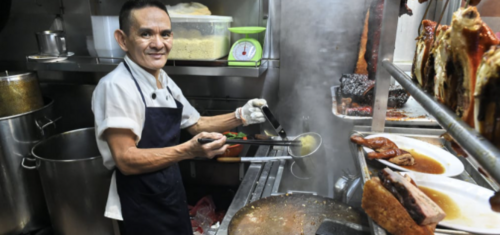Famed Singaporean eatery Hawker Chan loses its Michelin star

Famed Singaporean eatery Hawker Chan loses its Michelin star
Hawker Chan, known for offering the world’s least expensive Michelin-starred meal, has lost its Michelin star. Hawker Chan, founded by Chan Hong Meng, earned its Michelin star for its $2.50 ($1.85 USD equivalent) soy sauce chicken noodle dish in 2016. However, this year’s Michelin food guide to Singapore unfortunately did not include Hawker Chan. Following Hawker Chan’s loss of the star, a representative of Hawker Chan commented: “Chef Chan Hon Meng has prepared his famous soya sauce chicken rice since 2009 with his secret recipe and cooking method, which has not changed since the beginning of Hawker Chan in 2009....We do hope to understand why the Michelin Guide has left us out of the list this year. However, we also understand that everyone has their own opinion when it comes to food choices.”
After Hawker Chan was awarded the Michelin star in 2016, it quickly expanded. One hawker stall in Chinatown hawker center* turned into a franchise with locations all around Southeast Asia. Some praised chef Chan for his hard work on expanding his business, others felt that the food quality began to fall.
Hawker Chan is not the only establishment trying to protect their Michelin stars. The respected brand downgraded La Maison des Bois from three stars to two, which triggered its chef, Marc Veyrat, to due Michelin.
*Hawker centers are essentially food courts located all around Singapore (and other southeast asian countries). Hawker centers can be found in community centers, apartment complexes, and malls (even ‘upscale’ malls will have hawker centers). They are filled with food stalls (hawker stalls) that specialize in very few dishes and price their food similar to as described in the article (around $2.50). Personally, I feel that hawker centers play a big role in preserving culture. Many, if not all, of the dishes sold in hawker centers are local Singaporean or Southeast Asian dishes. Hawker centers not only preserve culture, but they also unite the community, and attract tourists (through Singapore’s famed foodie culture). Hawker centers often have big tables with numerous seats in the middle, and stalls around it, encouraging people to sit together and nurturing a boisterous environment.
Comments
Amelie,
In addition to the story of hawker Chan, it is interesting to me to think about the fixation Singaporeans have on the importance of hawker centers as emblems of culture. I have long noticed that whenever a Singaporean wishes to convince someone that there is indeed “culture” on the island they almost always refer to hawker centers. When we reflect on the discussions we had in class about the relationship of food and identity, I think there is something really fascinating going on here. My guess is that a hawker center is actually a kind of mediating space between “home” and restaurant. There are many people one might not quite invite home for dinner, but who one considers to be very familiar and close. One would easily go to a hawker center with such a person for a low key but delicious meal. On the other hand, there are many “high end” restaurants which would be reserved for other occasions. The names used to refer to hawker center staff (uncle, auntie) are also fictive kin terms, implying a kind of surrogate family, but one which is not exactly the same as one’s “real family.” How does the spatial arrangement of the center (both in terms of itself and in relation to surrounding HDB, metro hub, etc) as well as the kind of food served, produce a specific kind of sociality that in turn makes people identify hawker center with “Singaporean culture”?
Pages